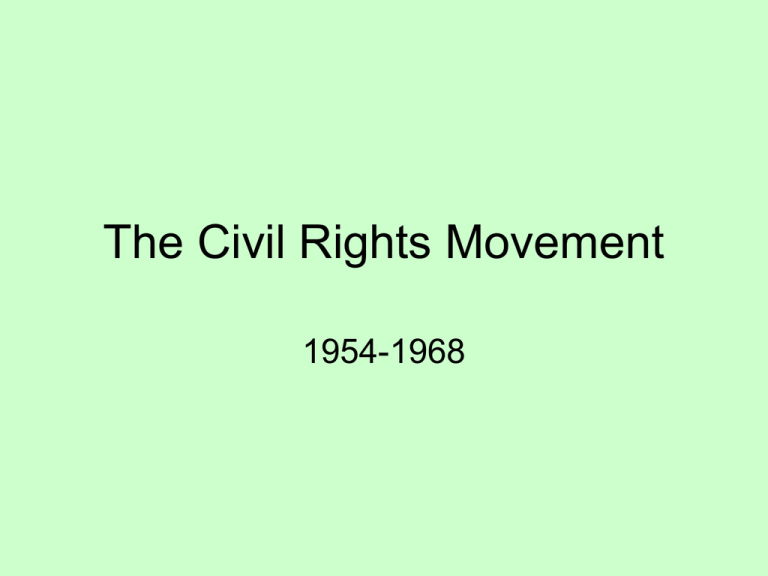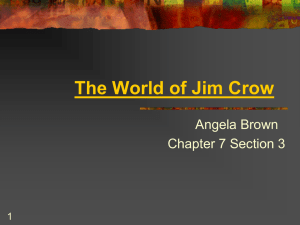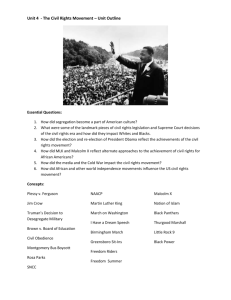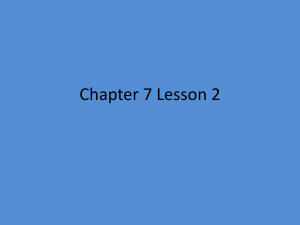The Civil Rights Movement - Public Schools of Robeson County
advertisement

The Civil Rights Movement 1954-1968 Origins of the Movement • Segregation had been declared equal when the Plessy v. Ferguson case of 1896 established the “separate but equal” doctrine. • These segregation laws were known as “Jim Crow” laws. • They segregated buses, bathrooms, trains, schools, restaurants, swimming pools, parks, and other public facilities. NAACP • The National Association for the Advancement of Colored People (*NAACP) was established in 1909 and supported court cases attempting to overturn segregation. • They supported efforts to end segregation. Brown v. Board of Education 1954 • In 1954, the Supreme Court heard the case of a young African American girl named Linda Brown- she was denied admission to a neighborhood school in Topeka, Kansas because of race. • With the help of the NAACP, her parents sued the school board. • The court ruled that segregation in public schools was unconstitutional. Linda Brown (Left) and family http://www.law.umkc.edu/faculty/projects/ftrials/conlaw/brownfamily.jpg The Montgomery Bus Boycott • In 1955, Rosa Parks boarded a bus in Montgomery, Alabama and refused to sit in the rear where African Americans were supposed to sit. • She was arrested. • Others, outraged by her arrest, called on African Americans to boycott Montgomery, Alabama’s buses the day Parks was in court. Rosa Parks http://www.pacificviews.org/weblog/archives/Pictures/rosa_parks_fingerprint.jpg The Montgomery Bus Boycott • They formed the Montgomery Improvement Association led by Martin Luther King, Jr., a 26 year old pastor. • King inspired his followers and encouraged ending segregation and racism through nonviolent and passive resistance. Dr. Martin Luther King, Jr. http://www.s150.msu.edu/1960-1969/mlk.jpg African American Churches • African American churches and ministers were some of the major leaders of the Civil Rights movement. • King established the Southern Christian Leadership Conference (SCLC) in 1957. Eisenhower • Eisenhower opposed segregation and sympathized with the goals of the Civil Rights Movement. • He also ordered more military facilities to be desegregated. • He did however oppose protests and court rulings- he felt that values had to change not just laws. http://www.cia.gov/csi/monograph/firstln/955pres18.gif Eisenhower • He became the first troop that had to send federal troops into the South to protect the constitutional rights of African Americans. • In 1957, the school board in Little Rock, Arkansas, won a court order to admit nine African American students to Central High- a white school. • The governor of Arkansas was really moderate but to win re-election he campaigned for white supremacy. Eisenhower • Governor Faubus ordered the Arkansas National Guard to prevent the nine students from entered the school. • Television coverage made Little Rock the center of national attention. • He was opposing the authority of the federal government. • President Eisenhower ordered U.S. Army troops to Little Rock- they escorted the Little Rock Nine into the school. • The troops remained through the school year to protect them. The Little Rock Nine http://amcop.blogspot.com/uploaded_images/little%20rock% 20nine-751046.JPG http://pbskids.org/wayback/civilrights/school/little_rock_nine.jpg Sit-In Movements • In 1959, four African Americans enrolled at North Carolina A&T in Greensboro performed a sit-in at a whites-only lunch counter in a Woolworth’s department store. • They were refused service, and they stayed until the counter closed and continued to do so. • The following day- 29 African American students were there. • 300 were present by the end of the week. Greensboro Sit-In http://www.loc.gov/exhibits/civilrights/images/cr0015th.jpg Sit-In Movements • The Sit-In movement spread to many more cities. • This was a form of peaceful protect. • Some African Americans were discouraged by the slow pace of desegregation. • Most remained peaceful, however. Young People • Many protesters were young people. • The Student Nonviolent Coordinating Committee was formed and played a key role in desegregating public facilities between 1960-65. Freedom Riders • Most bus travel remained segregated in the south, despite rulings outlawing segregation on interstate buses. • The federal government regulates interstate commerce so they can regulate the buses traveling over state lines, but states control those that just stay in the state because of the U.S. Constitution. • In 1961, teams of whites and blacks traveled to the South to draw attention to the segregated buses- they were called Freedom Riders. http://www.voicesofcivilrights.org/photoGallery/images/AARP_ photo_gallery_03.jpg http://images.encarta.msn.com/xrefmedia /sharemed/targets/images/pho/t028/T028 163A.jpg Freedom Riders • In 1961, the first Freedom Riders boarded several interstate buses. • Angry white mobs attacked them in Alabama- they slit tires, and threw rocks, and someone threw a firebomb into a busno one was killed. • Other riders faced angry gangs armed with bats, chains, and pipes and were beaten. • This violence shocked the nation. President John F. Kennedy • Kennedy took office in 1961, after winning the election of 1960. • He promised to actively support the civil rights movement. • He appointed many African Americans to government jobs and created the Committee on Equal Employment Opportunity (CEEO). http://www.cia.gov/csi/monograph/firstln/955pres24.gif Kennedy • Southerners had a strong hold on Congress, and Kennedy did not want to challenge them directly so he allowed the Justice Department run by Robert Kennedy, his brother, to actively support the civil rights movement. • They particularly focused on protecting the right to vote. Birmingham, Alabama • Birmingham was a center of violence during this time. • Martin Luther King, Jr. launched demonstrations in the city in 1963. • He was arrested, but felt this was the best way to get Kennedy’s attention. • He wrote his famous “Letter From a Birmingham Jail” while in the prison. Birmingham, Alabama • After he was released, the protests increased, and the Public Safety Commissioner of Birmingham, Bull Connor, ordered police to use clubs, police dogs, and high-pressure fire hoses on the demonstrators. • This was captured on television and horrified the nation. http://www.outofrange.net/blog archive/archives/mooreBirming ham.jpg http://www.gettysburg.edu/academics/engli sh/eng235/dog.jpg Civil Rights Act of 1964 • In 1964, President Johnson signed the Civil Rights Bill of 1964. • One of the major opponents, Governor George Wallace of Alabama, said, “I draw a line in the dust… and I say, Segregation now! Segregation tomorrow! Segregation forever!” March on Washington • In the summer of 1963, Dr. King delivered a powerful speech near the Lincoln Memorial in Washington, D.C. • Over 200,000 demonstrators came to march on Washington. • King gave his “I have a dream” speech at this time. King’s “I have a dream” speech • “I have a dream that one day this nation will rise up and live out the true meaning of its creed: ‘We hold these truths to be self-evident; that all men are created equal.’… I have a dream that my four little children will one day live in a nation where they will not be judged by the color of their skin but by the content of their character…. I have a dream that one day the state of Alabama… will be transformed into a situation where little black boys and black girls will be able to join hands with little white boys and white girls and walk together as sisters and brothers.” http://www.africawithin.com/bios/ml_king.jpg http://www.exodusnews.com/P hotos/MartinLutherKing.jpg Heart of Atlanta Motel v. U.S. • In 1964, the Supreme Court ruled that privately owned facilities like the above named hotel could not discriminate based on race Selma March • In 1965, the SCLC and Dr. King selected Selma, Alabama as a focal point to push voting rights protection. • They performed a march for freedom from Selma to the state capitol in Montgomery, about 50 miles. • A sheriff ordered them to disperse and while the marches kneeled in prayer, 200 state troopers and citizens rushed on them and beat them. • Cameras captured this- it stunned the nation. • They called in “Bloody Sunday.” http://www.africanamericans.com/images2/S elmaMarchMartinCoretta.jpg http://home.earthlink.net/~sistersofselma/selma3i.jpg Voting Rights Act of 1965 • The passage of the voting rights act marked a turning point. • The movement had achieved its two major goals- segregation had been outlawed with the Civil Rights Act of 1964 and new federal laws were in place to prevent discrimination and protect voting rights with the Voting Rights Act of 1965. Racism • This is prejudice or discrimination toward someone because of his or her race. • It still exists. Civil Rights Movement • Although two major legislative goals had been met by the movement, changing people’s attitudes would take much more time. • Achieving economic equality would also take more time. Black Power • Not all Civil Rights protestors chose nonviolent forms of protest. • Many African Americans around 1965 began to turn away from nonviolent protest and King and support more aggressive forms of protest. • Black power meant that physical selfdefense and even violence were acceptable in defense of one’s freedom. Black Power • Black power also stressed pride in the African American culture. • It emphasized racial distinctiveness rather than cultural assimilation and not becoming mainstream. Malcolm X • In the early 1960s, Malcolm X became a symbol of black power. • He joined the Nation of Islam- Black Muslims. • They were led by Elijah Muhammad- they did not hold the same beliefs as mainstream Muslims. • They believed African Americans should separate themselves from whites and form their own self-governing communities. http://shs.westport.k12.ct.us/jwb/Collab/CivRtsWeb/Images/malcolmx.jpg Malcolm X • Malcolm X was a powerful speaker and gained much attention for the black power movement. • In 1964, Malcolm X broke from the Nation of Islam and criticized the organization and leader. • As a result, he was killed in 1965, while giving a speech in New York. Black Panthers • In 1966, several men from Oakland, CA organized the Black Panther Party for SelfDefense. • They believed that a revolution was necessary and encouraged African Americans to arm themselves and confront white society and force them to grant them equal rights. • They recruited the urban poor mostly. Martin Luther King, Jr. • By the late 1960s, the civil rights movement had divided into competing sects. • Dr. King went to Memphis, TN to support a strike in April of 1968. • He was assassinated by a sniper. • He had said earlier, “I’ve been to the mountaintop… I’ve looked over and I’ve seen the Promised Land. I may not get there with you, but I want you to know tonight that we as a people will get to the Promised Land.” Martin Luther King, Jr. • His assassination touched off national mourning. • Three major leaders of the Civil Rights Movement had been assassinatedKennedy, Malcolm X, and King. • They did, however, greatly influence American society in their day and in the future as well. Election of 1968 • In 1968, Johnson did not run again as the Vietnam War turned sour • The Republicans chose Nixon to run again (he lost to Kennedy in 1960) • The Democrats were trying to choose between him and Eugene McCarthy (not Joseph McCarthy) but Bobby Kennedy was shot in June 1968 • He had been attorney general under his brother’s presidency and had also been a major proponent of civil rights • Nixon won the election Legacy of the Civil Rights Movement • Ended legal segregation and discrimination in public and private facilities • Racism and discrimination still existed • More pride in African American communities • More African American political participation • Much unfinished business






